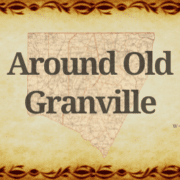TownTalk: Around Old Granville – Historical Markers
The state’s very first official historical marker was erected in 1936 – just a year after the Highway Historical Marker Commission was established. But where was it placed? Any ideas?
If you said Granville County, you’d be correct. The first marker honors John Penn, one of North Carolina’s three signers of the Declaration of Independence.
But Old Granville County – that four-county area that includes Vance, Warren and Franklin along with Granville – has a total of 57, said Mark Pace, local historian and North Carolina Room specialist at Oxford’s Thornton Library.
The state’s 100 counties are divided into 17 regions; Vance and Granville counties each boast 15 markers and are in Region G; Franklin and Warren, both in Region E, have seven and 20, respectively.
Pace and WIZS’s Bill Harris are tackling the topic of historic markers for the next few “Around Old Granville” segments of TownTalk. First up, Granville County.
The John Penn marker, located along Highway 15 in Stovall, was issued along with four others in the inaugural group, Pace said.
Interestingly, Granville County has the oldest marker, but also two of the newest: Camp Butner got a marker in 1989 and James E. Webb, who was instrumental in the creation of NASA and the space program, got a marker in 2018.
The commission started its work with the marker program as the country was emerging from the economic devastation of the Great Depression, which Pace said showed the state’s commitment to history. There are criteria for getting a marker approved and placed, he said, including placement in a prominent location on official state highways.
Webb’s marker, for example, is located along College Street in Oxford. He grew up a block away, Pace said.
Thomas Person has a historical marker in Granville County. He was probably the wealthiest person who ever lived in Granville County and owned 80,000 acres. But that’s not what got him a marker along Highway 158 back in 1972. His marker reads “Leader of popular movements: Regulation, Revolution and Antifederalism. His home in Goshen stood five miles north.”
Pace observes what he called “commemoration fever” when it comes to remembering historical figures or events. There seems to be renewed interest in history 50 or more years after an important event, he said.
“It’s kind of like the Rock and Roll Hall of Fame,” he said. Rockers aren’t considered until 25 years after their first record is released.
Horner Military Academy got a marker in 1939. It was known nationally because of the prominent people who attended the private school, which was established in 1851 by James JH. Horner.
There’s a marker for Henry Plummer Cheatham, who was born into slavery and served in the U.S. Congress from 1889-1893. Cheatham also was the superintendent of what is now Central Children’s Home for close to 30 years until his death in 1935. His marker can be seen on N.C. 96 at Eighth Street in Oxford.
Central Children’s Home – and the Masonic Home for Children, the other orphanage in Oxford, also have markers, placed in 1965 and 1936, respectively.
A marker for Mary Potter Academy was erected in 2005 along College Street, also known as U.S. 158 Business. Its inscription reads: “Founded by G.C. Shaw 1889 to educate African Americans. Named for a Presbyterian benefactor. Later a public school. Operated one block E.”
Bullock has one of five markers in Region G that identifies the Native American Trading Path that was subsequently used by colonists and settlers between Petersburg, VA and well into North Carolina – Hillsborough and beyond. There’s also a Trading Path marker in Vance County, but that’s a story for another day.
Check out all the historical markers in Granville County and across the state at https://www.dncr.nc.gov/about-us/history/division-historical-resources/nc-highway-historical-marker-program
CLICK PLAY!



